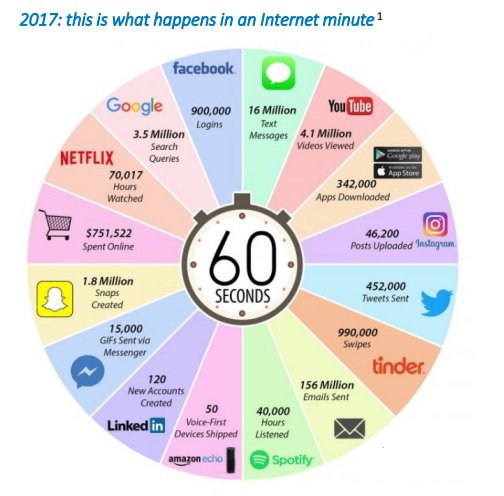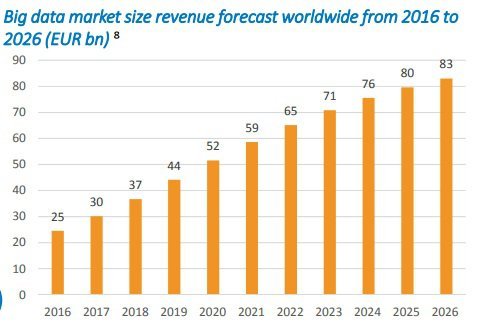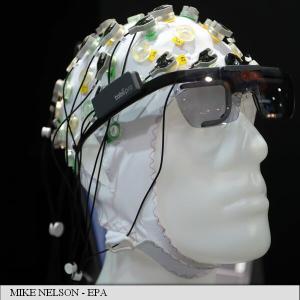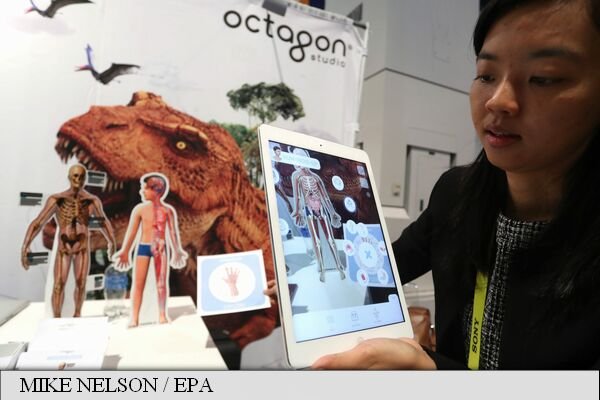How much "work" Google, Facebook and YouTube in a minute.
source: jurnal.md
The digital industry has reached a record year of use and will continue to grow exponentially in the next decade, according to profile studies.
3.5 million searches on Google, 16 million text messages sent, 900,000 Facebook logos, 4.1 million views on YouTube. All this happens at the level of 2017, within just one minute, according to research conducted by DigitalEurope.
Also, for only 60 seconds, 120 new LinkedIn accounts are opened, 452,000 Twitter posts and $ 751,522 in online stores.
image source: capital.ro
The best performing digital economy, according to a study by Huawei, is the USA, Singapore, Sweden, Switzerland, UK. In the Top 10 ranked Denmark, the Netherlands, Japan, South Korea, Norway.
Compared to other areas, Europe is not as good as we would have expected, so it should invest 90 million euros annually over the next 15 years to be a model in industry 4.0, DigitalEurope representatives said.
The world's big data market recorded last year revenues of 25 billion euros and estimates a level of 30 billion euros for 2017. Total revenues on this market will reach 83 billion euros in 2026, according to experts.
image source: capital.ro
"Artificial intelligence and robotics are the technologies of the future, and everything else is simple," says Franck Cohen, president of Europe, Middle East and Africa, at the SAP software giant.
By 2022, the artificial intelligence market is expected to reach 14.3 billion euros, after an increase of over 62% compared to 2016.
source: capital.ro
CES 2017: Robotics and Artificial Intelligence for People with Disabilities.
The US startup BrainRobotics presented at CES, the world's largest electronics trade fair in Las Vegas on 5-8 January, a hand-held prosthesis capable of interpreting signals sent by the user's residual muscles.
Thanks to the progress of artificial robotics and intelligence, the cutting-edge technology sector offers new hopes to improve the lives of people with disabilities, EFE reports.
BrainRobotics founder Bicheng Han said he wanted to "provide a low-cost but functional" prosthesis that would allow precise control of the force exerted by each finger. The company plans to sell this prosthesis by the end of this year at $ 300, as the product sells tens of thousands of dollars.
The prosthesis is initially calibrated for each individual. By engaging artificial intelligence, the user provides a data base repeating each gesture on different occasions. The procedure that can be done at home should last for an average of one month for each user, with at least 50% of the residual muscles, said the developers.
Another innovative product made by Israeli company Orcam and presented at CES is a small device titled MyEye, which adapts discreetly to a pair of glasses. The device contains a camera that "looks at" what is in front of the user and a small speaker through it can hear. The user can read text, identify products in a supermarket or even people, thanks to this visual recognition technology.
Another innovation is the introduction of the Danish Oticon startup and refers to interconnected objects in a home. This time, the interfaced hearing aid can receive a direct message in the user's ear when someone calls for example at the door or automatically switches on the coffee maker.
In turn, Hyundai is ambitious to improve paralysis by creating robotic exoskeletons. A prototype presented at ESCs is primarily aimed at paraplegic individuals who are able to lift, walk or even climb the stairs, according to Jung Kyungmo, a research engineer at this South Korean company.
The device called H-MEX is mounted along the spine and attached to the waist, thighs, knees, and legs. An engine system allows triggering of rotational movements at the joints by means of a remote mounted crutches system. "Production is not yet planned for the general public, but we do clinical trials in hospitals," confessed Jung Kyungmo, on the H-MEX model.
source: agerpres.ro
The most accepted definition of artificial intelligence was given by John McCarthy in 1955: "a car that behaves in a way that could be considered intelligent if it were a man." More broadly, artificial intelligence targets the study and design of intelligent agents, systems that perceive the environment and maximize the chances of success through behavior. [1]
A common feature of artificial intelligence is that the system is capable of learning, with or without external aids, in order to constantly improve.
The central issues of research in AI are reason, knowing, planning, learning, processing natural language (communication), perception, and manipulation of physical objects. [2]
source: wikipedia.org





